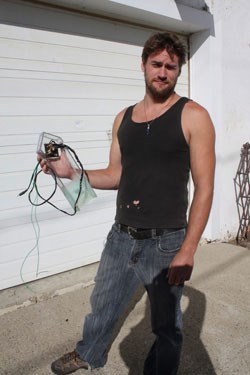The majority of 3D printers on the market today are big, complicated and expensive. Yorkton inventor Rylan Grayston's Peachy Printer is the opposite of that, a 3D printer for $100, and the promise of the device has caught on, raising over $500,000 of investment through crowdfunding site Kickstarter.
The difference between the Peachy Printer and other 3D printers is the way it works. Instead of complicated mechanical methods, a light-sensitive resin - in plastic, silicone and rubber right now - which will become the printed object floats on the surface of some salt water. In another tank is more water, which drips into the bottom tank, allowing the resin to rise and give the objects a 3D shape. The other component of the printer uses mirrors and a laser beam to focus light on the desired part of the resin.
The printer gets information from a sound file, read from an audio jack. Grayston explains that this does not actually save very much money in construction, but does make a big difference to the usability.
"Because I've chosen to stay with audio, and because every smartphone has an audio output and a microphone input, you will be able to use a smartphone to use the printer. That means that [it can be used by] people who can't afford computers but can afford cell phones - and this is I believe a situation in third-world countries, there is a lot of cell phones and they are doing really innovative things with them down there."
The goal from the outset was to make 3D printing ubiquitous, and Grayston says that the challenge was finding ways to strip the cost out of a system, and use methods that are free or use as little money as possible.
"You have to put your brain into specific situations that force your thinking out of the box that you grew up in. For example, if you were in the 3D printing business, you would grow up in a box that says these things are expensive and this is how you do it. This is why these things are expensive, and that's a fact... I like to ask myself questions that spur the impossible, how can I do something absolutely for free? The hole in the bucket is an example of that, the hole that the dripping happens through doesn't cost anything, so that is the solution."
The project is entirely open source, allowing people to modify the software and hardware as they see fit when the project is complete. Grayston says that he believes that if a creator does not allow people into the source, they greatly limit the power of their inventions and the progress they can make, and he believes that going open is the key to maximizing the potential of the device.
"The printer has so many things that it can do that if you decided that you wouldn't share it and wouldn't share the code and wouldn't let people add to it, you would limit it a lot."
Grayston has been working on the project for a year so far, and has been thinking about it for a year and a half. He admits that it has taken over his life, but that inventing things has always been the way he wants to work, and he's glad that he has an idea that has allowed him to become devoted completely to its development and has found success already, allowing him to devote all of his time to its development.
With the amount of money raised being so much more than was initially asked for, Grayston admits that the pressure is on, and the team will have to deliver on the promise on the device now that they have received such a large international following. When someone makes an investment to fund a Kickstarter project, they assume some risk, as it is possible that a project might not see results. Grayston says his reputation is on the line, and with his team they know they have to spend the next year perfecting the device.
"It's completely incorrect to look at this as Rylan Grayston and his Peachy Printer team got rich, it isn't. We actually just got ourselves in a huge amount of debt. We owe the world something that's worth ten times the money that we got for what we're going to deliver by today's standards. But we're changing the standards, and we've shown how we're going to do that. What we're doing is taking a huge debt to the world, and a risk, and you've set aside a plan that you can do it with the funds that you've got," Grayston says.
"At the same time, I feel relieved as it goes larger. As it grows, the better the numbers get, the better I can delegate tasks to the right people. My worst fear would be selling 200 of them and sitting in a shop by myself for six months making them by hand, whereas if I sell thousands and thousands of them, I can hire people who are experts at doing pieces of the project, and have everything done really efficiently."
For more updates on the Peachy Printer project or to back it, visit peachyprinter.com.




